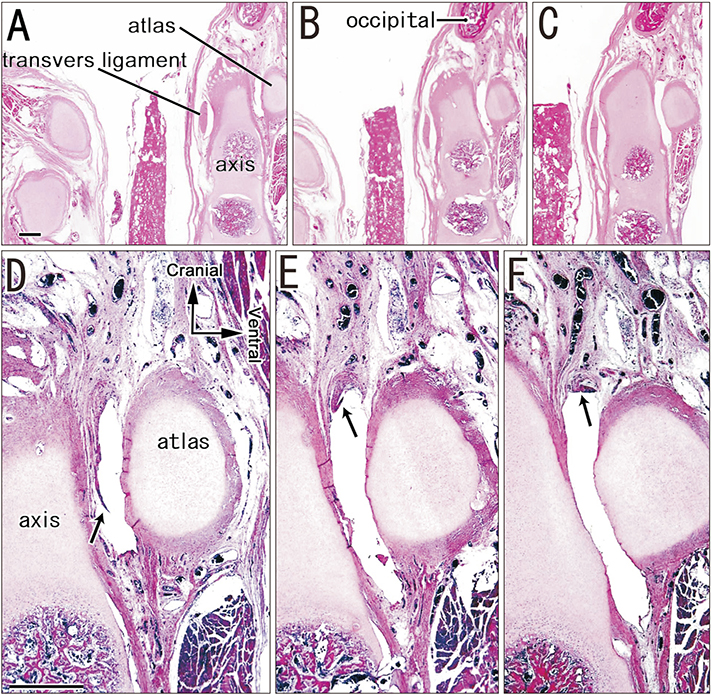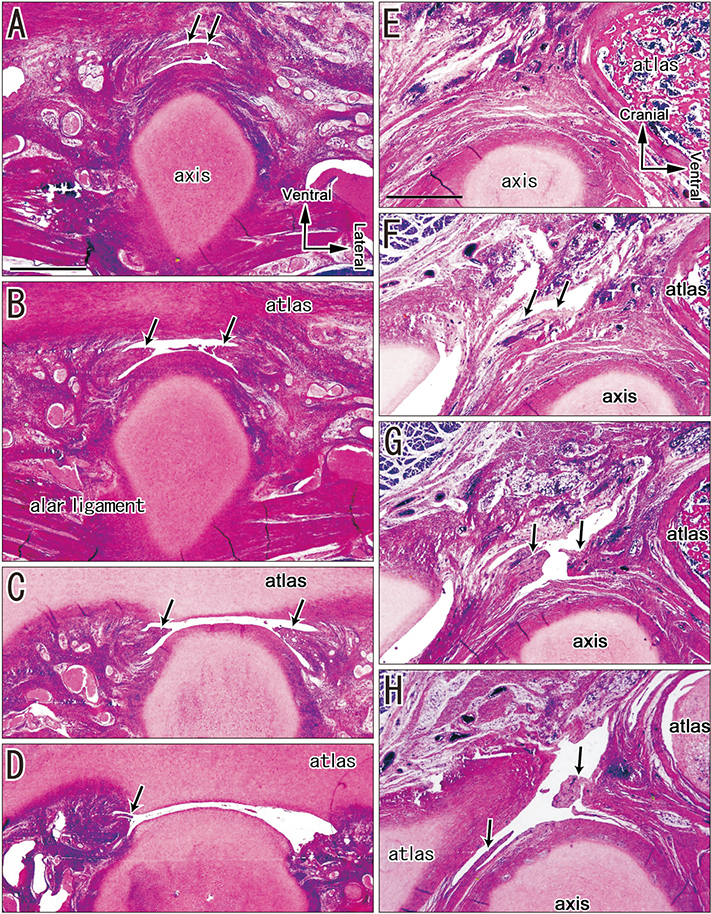Anat Cell Biol.
2019 Dec;52(4):436-442. 10.5115/acb.19.128.
A temporary disc-like structure at the median atlanto-axial joint in human fetuses
- Affiliations
-
- 1Department of Anatomy, Tokyo Dental College, Tokyo, Japan. yamamotomasahito@ tdc.ac.jp
- 2Department of Anatomy, Chonbuk National University School of Medicine, Jeonju, Korea.
- 3Division of Internal Medicine, Jikou-kai Clinic for Home Visits, Sapporo, Japan.
- 4Department of Anatomy and Embryology, School of Medicine, Complutense University, Madrid, Spain.
- KMID: 2466697
- DOI: http://doi.org/10.5115/acb.19.128
Abstract
- During observations of mid-term and late-stage fetuses, we found a joint disk-like structure at the anterior component of the median atlanto-axial joint. At mid-term, the disk-like structure was thick (0.1-0.15 mm) relative to the sizes of bones surrounding the joint. However, it did not completely separate the joint cavity, and was absent in the inferior and/or central part of the cavity. This morphology was similar to the so-called fibroadipose meniscoid of the lumbar zygapophysial joint that is usually seen in adults. In mid-term fetuses, there was evidence suggesting that a mesenchymal tissue plate was separated from a roof of the joint cavity. In late-stage fetuses, the thickness (less than 0.15 mm) was usually the same as, or less than that at mid-term, and the disk-like structure was often flexed, folded and fragmented. Therefore, in contrast to the zygapophysial meniscoid as a result of aging, the present disk-like structure was most likely a temporary product during the cavitation process. It seemed to be degenerated in late-stage fetuses and possibly also in newborns. Anomalies at the craniocervical junction such as Chiari malformations might accompany this disk-like structure at the median atlanto-axial joint even in childhood.
Keyword
Figure
Cited by 2 articles
-
Fetal development of the human trapezius and sternocleidomastoid muscles
Kwang Ho Cho, Ichiro Morimoto, Masahito Yamamoto, Shinya Hanada, Gen Murakami, Jose Francisco Rodríguez-Vázquez, Shinichi Abe
Anat Cell Biol. 2020;53(4):405-410. doi: 10.5115/acb.20.202.Fetal cervical zygapophysial joint with special reference to the associated synovial tissue: a histological study using near-term human fetuses
Kei Kitamura, Shogo Hayashi, Zhe Wu Jin, Masahito Yamamoto, Gen Murakami, José Francisco Rodríguez-Vázquez, Hitoshi Yamamoto
Anat Cell Biol. 2021;54(1):65-73. doi: 10.5115/acb.20.265.
Reference
-
1. Cave AJ. On the occipito-atlanto-axial articulations. J Anat. 1934; 68:416–423.2. Cave AJ. The morphology of the mammalian cervical pleurapophysis. J Zool. 1975; 177:377–393.3. Abe H, Ishizawa A, Cho KH, Suzuki R, Fujimiya M, Rodríguez-Vázquez JF, Murakami G. Fetal development of the transverse atlantis and alar ligaments at the craniovertebral junction. Clin Anat. 2012; 25:714–721.4. Engel R, Bogduk N. The menisci of the lumbar zygapophysial joints. J Anat. 1982; 135:795–809.5. Isogai S, Murakami G, Wada T, Ishii S. Which morphologies of synovial folds result from degeneration and/or aging of the radiohumeral joint: an anatomic study with cadavers and embryos. J Shoulder Elbow Surg. 2001; 10:169–181.6. Mérida-Velasco JA, Sánchez-Montesinos I, Espín-Ferra J, Mérida-Velasco JR, Rodríguez-Vázquez JF, Jiménez-Collado J. Development of the human elbow joint. Anat Rec. 2000; 258:166–175.7. Gray DJ, Gardner E. Prenatal development of the human knee and superior tibiofibular joints. Am J Anat. 1950; 86:235–287.8. Azahraa Haddad F, Qaisi I, Joudeh N, Dajani H, Jumah F, Elmashala A, Adeeb N, Chern JJ, Tubbs RS. The newer classifications of the chiari malformations with clarifications: an anatomical review. Clin Anat. 2018; 31:314–322.9. Pang D, Thompson DN. Embryology and bony malformations of the craniovertebral junction. Childs Nerv Syst. 2011; 27:523–564.10. Prescher A. The craniocervical junction in man, the osseous variations, their significance and differential diagnosis. Ann Anat. 1997; 179:1–19.11. Shoja MM, Johal J, Oakes WJ, Tubbs RS. Embryology and pathophysiology of the Chiari I and II malformations: a comprehensive review. Clin Anat. 2018; 31:202–215.12. Shoja MM, Ramdhan R, Jensen CJ, Chern JJ, Oakes WJ, Tubbs RS. Embryology of the craniocervical junction and posterior cranial fossa, part I: development of the upper vertebrae and skull. Clin Anat. 2018; 31:466–487.
- Full Text Links
- Actions
-
Cited
- CITED
-
- Close
- Share
- Similar articles
-
- A Case of Grisel Syndrome Showing No Underlying Laxity of the Atlanto-axial Joint
- Atlanto-Axial Joint Block: Case reports
- Quadriplegia and Dyspnea Caused by Os Odontoideum in a Down Syndrome Patient: A case report
- Combined Chronic Occipito-atlantal and Atlanto-axial Rotator Fixation with Cerebral Palsy
- Normal range of atlanto-denal interval






